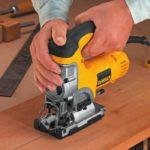To get excellent performance and long term service from a chain saw, you have oil your chain saw regularly. Do you know how to oil a cahin saw? If you are unfamiliar with oiling a pole saw, no worries because this guide will cover everything related to oil, a chain-saw.
A Chain or power saw has different parts, and out of them, the Chain and bar of a cahin saw or a pole saw are essential parts that play a crucial role during a pruning operation.
When the saw is running, these 2 parts come into continuous contact. Over time, they get dull, and regular lubricating is necessary to get the best performance. Because a chainsaw’s performance entirely depends on the performance of the Chain.
However, using different types of oil, you can lubricate your saw.
Let’s get to it!
Benefits of Oiling a Pole Saw
Before performing any action, we all look for an answer to a question – “what benefit will I get by performing this action?” The question is logical because if we don’t benefit from an action, we don’t show any response to do the action.
Similarly, oiling a chain saw also has some benefits, which I have discussed in the below.
- While a chain saw operates, the Chain and bar come into contact and create substantial frictions and heat.
- As a result, both can get damaged. Regular oiling (lubricant) will ensure to reducing heat and friction and prevent any damage that will happen to these 2 parts, and you will get long-term service from your Chain saw.
- The Chain will become dull or dent if you don’t oil your pole saw regularly. Finally, it will impact your cutting or pruning or trimming performance. So, to keep the Chain sharp, oil your pole saw periodically.
- The chain saw efficiency would increase if it gets proper oil regularly.
Different types of Chain saw, and Pole saw oil.
Are you a newbie to chainsaws?
And need to know what kind of oil you put in a chainsaw?
Or maybe you’re an experienced chainsaw user and asking yourself the question, “What can I use for lubricant on a chainsaw bar and chain?
You can’t avoid the friction between the chain and bar of a chain saw. When a chain saw runs, they create a high level of heat due to this friction. And this friction is harmful to a pole saw. That is why bar and chain oils or lubricants are specially formulated to be viscous enough.
3 types of oil or lubricant are required for a pole or chainsaw.
- Summer oil or More viscous oil
- Winter Oil or Thinner Oil
- All season Oil or Premium oil
So keep reading, because I'm going to share with you a vital information for chainsaw/pole saw oil or lubrican.
Summer oil or More viscous oil
We know, the friction of a chain and bar on your chain saw generated a lot of heat when the chain will rotate and it will be cause of damage of your saw. The resistance gets reinforced when you use a good lubricant.
First, you will need to know what type of oil will be beneficial for your Chainchasaw.
During summer, oil or lubricants become thicker than the winter season. If you don’t choose more viscous oil, the oil will fly off shortly. This way, overheating and poor performance will be a regular character of your pole saw. So, in the summer, you have to use summer or thicker oil.
Winter Oil or Thinner Oil
During winter, the only way to get better performance from a chainsaw is - carefulness. For this reason, you have to choose thinner oil or lubricant for your Chain and bar. Since the temperature is less in the winter, so cutting with a saw is pretty challenging.
So, taking additional care at the time of winter is necessary. Clean the Chain and bar of your pole saw regularly. Regular chain sharpening and sprocket greasing will make your pole saw much efficient.
Because of the cold weather, your power saw can get destroyed. Using winter or thinner oil will save your saw from this issue.
However, the chain-saw the manual contains all this information. Visiting the manufacturer website will also help you to get more suggestions.
All season Oil or Premium oil
Purchasing a different type of oil during the different seasons is a bit of an irritating task. To save you from such an irritating task, few manufacturers introduced bar and chain oil for All-season formula oil.
This type of oil can be used during both the summer and winter seasons. And a one-time purchase for a whole season is enough. It means going to your nearest store frequently for purchasing bar and chain oil is unnecessary.
The unique feature of the all-season bar and chain oil is that in broad temperature ranges, you will not face any problem to use it. Also, they have premium additives that reduce friction and wear. Moreover, boosting up chain lifespan is its prime responsibility.
Guides to oil your Chain or pole saw properly.
In this section, I will talk about how to oil your Chain-saw also a chainsaw/ pole saw following a correct method. The good news is, a chain saw can hold the same type and level of oil or lubricant in its tank.
Step 01: Preparing the chainsaw for the lubrication process.
Firstly, place your chain-saw on a flat surface. Put the bar side down so that the pole saw remains leveled.
Make sure; you have chosen the right oil for your pole saw. Remember, poor or imperfect oil will do more damage to the chainsaw instead of doing good. You can take assist from the manufacturer’s manual to learn which oil will suit your pole saw best.
Step 02: Lubricating the Chainsaw
Naw you can start lubricating it. A small funnel will be a great tool during the whole process. Don’t forget to turn off the power source while oiling. Remove the battery and keep aside.
Step 03: Filling up the reservoir to the right level
The reservoir has an open side, place the funnel to this side. Don’t make a hurry, slowly pour the lubricant. Remember not to overfill the reservoir. Otherwise, you will face a real mess. If the oil tank is transparent, then you can check the oil level quickly.
Step 04: Cleaning and assembling
Once the reservoir gets filled fully, place the cap to its position, and make sure it is well-tighten. Take a damp cloth, clean the Power saw thoroughly, and wipe out any additional lubricant around the tool.
Check whether the cap has a breathing hole or not. If it contains a breathing hole, don’t place the pole saw upside-down.
You have to do some extra work once refueling is done. Inspect the nose bar, add some oil if it has a bar nose sprocket. With a grease gun, you can complete this task effortlessly.
Conclusion
Bars and chains are manufactured in such a way that they require petroleum-based lubricants. You are solely responsible for not following the manufacturer’s recommendations or selecting any alternatives.
If your pole saw/ Chainsaw gets crippled by using any other than the suggested types, the manufacturer will annul the warranty.
After every use, inspect the oil tank if the oil level is below the recommended level, don’t do late, fill up the oil tank immediately. Always follow the manual whenever you face any problem.
FAQs
You can’t avoid the friction between the Chain and bar of a pole saw. When a pole saw runs, they create a high level of heat due to this friction. And this friction is harmful to a pole saw. That is why bar and chain oils or lubricants are specially formulated to be viscous enough.
Chainsaw/pole saw bar and chain oils or lubricants are specially formulated to be viscous enough.
If your chainsaw manufacturer’s bar and chain oil are not available, according to the University of Missouri Extension, you can use SAE 30 weight motor oil to lubricate your chain for a sublime period during the summer and SAE 10 weight during the winter.
Manufacturers consider petroleum oil the standard for lubricant bar and chains of a chainsaw—an Experienced chainsaw user used heavier oil in summer and lightweight in winter. Recently, several manufacturers have introduced oils for all seasons. If they are not available, the owner’s manual suggests alternatives.





